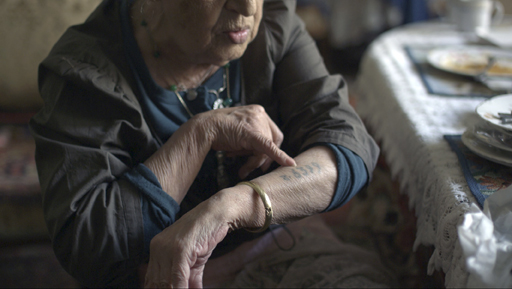A solitary figure walks slowly down a long wooded path. In voice-over we hear him all but whisper in a tone that hints of defeatism, that he wants to tell the story of the Roma. The subsequent opening credits footage, dominated by gray, dismal images and backdrops, foretells the grim nature of what is about to follow. In terms of the origins and history of a people, the film raises more questions than it answers, but as an account of discrimination towards a minority culture, this documentary is powerful evidence of the capacity for disregard and cruelty.
Variously referred to as gypsies, Roma, and Sinti (in Germany), and believed to have roots in India, the Romani share a common language, culture, and, most notably, the lack of a homeland. Long romanticized in movies, TV, and song, the reality of their lifestyle is far removed from how they are portrayed in the media.
The film takes its audience to communities throughout Europe to witness deplorable living conditions, and lists the many ways in which the Romani are currently being discriminated against by local governments. Noticeably lacking is a historical discussion of the term “gypsy” (which in many European languages refers to one who lies, cheats, or steals). Their situation is blamed on a history of slavery and segregation that has forced them to live primarily nomadic lives in poverty. The majority of the documentary focuses on their treatment during the Holocaust, and it begs the question, what is to prevent widespread genocide of the Romani people from happening again?
Director/writer Aaron Yeger makes ample use of archival photographs and footage to illustrate the stories told in vivid detail by Roma Holocaust survivors. They recount their memories of being tricked into captivity, or rounded up and forced into cattle cars; of what they witnessed while in the prison camps; and, in one chilling description, experienced at the hands of Dr. Mengele.
A general discussion of discrimination and the aspects of human nature that led to the Holocaust and more recent genocides is woven throughout. Lest we consider this to be strictly a European problem, the disenfranchisement of the Romani is frequently likened to our own history of discrimination against minorities. Conversely, the story of African Americans and the inclusion of the words of Dr. Martin Luther King, Jr. serve as a beacon of hope.
With fascism on the rise in some countries in Europe, the Romani face an uphill battle for equality. Even attempts to educate people about the Romani community have been sabotaged. As the film draws to a close, the woodland path in the opening scene is identified as a park now in the Czech Republic, where thousands of Holocaust victims were buried, and which the Czech government actively attempted to prevent being turned into a memorial site.







Leave A Comment